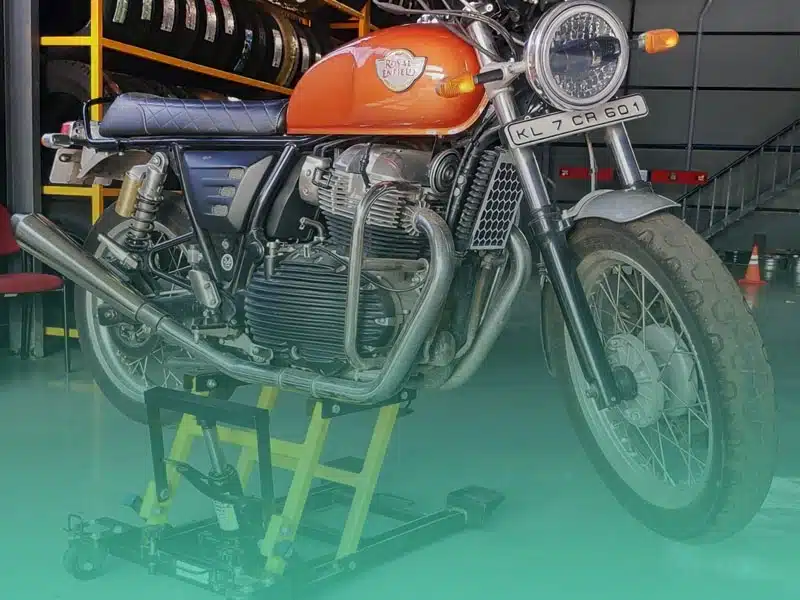Jacks are one step ahead of the center stands. They are the most crucial tool for removing motorcycle wheels. In fact, jacks are used for performing basic bike cleaning and maintenance procedures like oiling, washing, and repairing. They keep the bike stable, balanced, and level.
You might be wondering how to jack up a motorcycle; the guide below will answer your queries. You can use a car, floor, or motorcycle jack to perform this task.
Motorcycle enthusiasts like jacking up their bikes on their own instead of sending them over to a workshop. The process looks relatively easy and less challenging. Less than 15 minutes are needed, and voila, you are done!
What is a motorcycle jack?
Jack is a stand for lifting the bike with maximum safety and minimum effort. If it is your first time using this apparatus, you must practice a lot to become a pro. Many risks are involved if you do not know the ABC of using Jack. It can easily slip if not positioned properly, so beware.
How to jack up a motorcycle?
The guide will explain to you how to jack up a bike safely, so let us see the details:
Step 1
Look for the solid flat surface where you will place the bike. The surface must be sufficiently high enough that the bike’s front-end wheel stays slightly higher than the back-end wheel.
In doing so, you can properly balance the bike and prevent it from getting shaking or unwanted moving. Jack stands work at their best when the ground’s surface looks even; this way, the apparatus will not budge.
Furthermore, you can use a car, floor or motorcycle jack; the choice is yours. The process of operating these jacks is almost similar. The lifting process involves raising the bike and bringing it upright. As a bonus tip, you can use wood blocks if you do not have a jack.
Step 2
Identifying the bike’s center of gravity is one of the trickiest parts of this entire process. The center of gravity is the crucial and prime point where the whole weight of the motorcycle can be supported without falling over.
Your job is to look for that spot; only then the bike will not tilt or unnecessarily trip over.
You can find your bike’s center of gravity by raising its front wheel and moving it back and forth to get a rough idea of where the center of gravity lies. Once you have identified the spot, mark it using chalk.
Another bonus tip for you: Sportbikes do not have a center stand. Frame rails are used to lift them. It is a critical safety measure that all bike enthusiasts must remember. Using a frame rail protects the bike’s exhaust system, and you can effortlessly change the tires.
Step 3
After locating the center of gravity, thoroughly examine the underside section of your motorcycle. Ensure the contact surface is flat. Look for the jacking points; they usually exist between the jack stand and the bike, near the engine or suspension system. Moreover, these points must fit onto the metal surface. They should not move at all!
Step 4
Adjust the position of your motorcycle; bring it to an upright position. If the bike is tilting or leaning excessively on one side, you can use a wooden block to balance its rear end.
Step 5
As soon as you bring your bike in a stable and upright position, now comes the task of positioning the jack correctly. Place it directly under the marked ‘’center of gravity’’ spot. In addition, it should be pointing to the right jacking point. You can now secure the jack stands using a chain or strap to avoid falling over.
Step 6
You have set everything in its position; the next step is to lift your bike slowly and gradually until and unless it balances itself on the top of the jack stand.
Ensure there is no slack. Putting the bike up on a frame slider is recommended to protect other valuable parts of your bike, including the front brake lever.
Voila, you are done! Your bike has been successfully lifted. You can now perform the desired task, be it removing the wheel, oiling/lubricating the rusted components, cleaning and washing the whole bike, etc.
Why Jack get stuck?

The jack, at times, gets stuck/jammed in the up or down position; why does this happen?
The most common reason is that the air gets locked within the hydraulic pump. This prevents the jack from showing full range and lifting/lowering capability. It is recommended to bleed the air to get rid of this problem.
There is another reason, too- the jack does not go up due to incorrect fluid levels. Removing the oil plug and properly looking into the chamber to see the oil level are suggested. The recommended oil level is 3/16 to a quarter right above the reservoir.
What happens when the jack is not properly positioned?
Uncountable hazards are involved when the jack is not properly positioned. Placing it on an uneven surface might cause you to suffer severe injuries.
Thousands of amateur mechanics have encountered fatal wounds because they have incorrectly placed the jack, and the surface was not flat and even. Such blunders push the jack stand to collapse eventually.
For beginners, mini ramps seem a much safer alternative than jack stands. You can first practice using mini ramps and then use a jack.
Lastly, never use a jack without a stand. The results will be worse and nothing less than that.
Conclusion
That is all about how to jack up a motorcycle! If you still have questions about this jacking-up guide, please ask us. The jack is undoubtedly the most useful tool for removing wheels and oiling, repairing, cleaning, and washing the bike. Please stay connected with us for regular updates.
